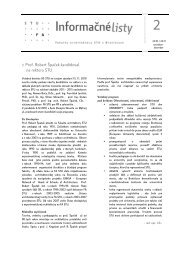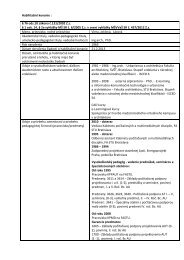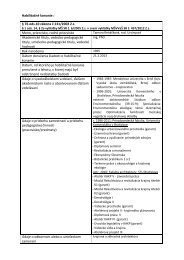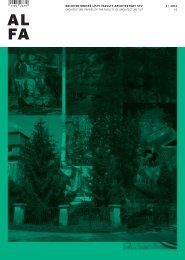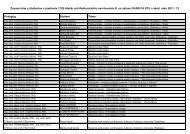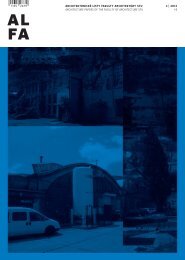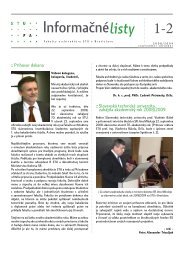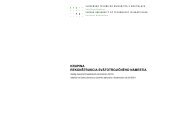ALFA 3-4/2005 - Fakulta architektúry STU
ALFA 3-4/2005 - Fakulta architektúry STU
ALFA 3-4/2005 - Fakulta architektúry STU
You also want an ePaper? Increase the reach of your titles
YUMPU automatically turns print PDFs into web optimized ePapers that Google loves.
Ročník 9<br />
3-4 / <strong>2005</strong> ARCHITEKTONICKÉ LISTY FA <strong>STU</strong><br />
space/non-space between these opposites. The aim is to 'grasp'<br />
it, or (using Foucalt's terms) to articulate or visualize this open<br />
gap. Blurring, healing, continuity and fluidity become means of<br />
expressing of these aims.<br />
The most common tool for grasping this space/non-space has<br />
become a diagram.<br />
Architect Peter Eisenman in his book Diagram Diaries divides use<br />
of the diagram into two main methods. He describes how<br />
a diagram is used by J.Derrida and on the other side by<br />
G. Deleuze and M. Foucault. Derrida's diagram can be compared<br />
to Freud's 'Mystic Writing Pad' which consists from three layers.<br />
The outer one or surface is where the writing takes place,<br />
the middle layer transcribes the text from the upper to the lower<br />
one, on which the inscription form of the writing is retained. This<br />
tool offers endless possibilities of writing and subsequently<br />
rewriting on its upper layer and consequently ‘recording’ many<br />
series of superimosed marks into the lower layer.<br />
”The architectural diagram, like Mystic Writing Pad, can be<br />
conceived of as a series of surfaces or layers which are both<br />
constantly regenerated and at the same time capable of retaining<br />
multiple series of traces.” 2<br />
“The diagram understood as a strata of superposed traces offers<br />
the possibility of opening up the visible to articuable, to what is<br />
within the visible. In this context architecture becomes more than<br />
that which is seen or which is present; it is no longer entirely<br />
a representation or an illustration of presence. Rather, architecture<br />
can be re-presentation of this intervening apparatus called<br />
diagram.” 3<br />
Peter Eisenman emphasised 4 that the result of the Derida's<br />
diagram is a layer of superimposed inscriptions, in which he<br />
consequently finds/concretizes the resulting form. In the opposite,<br />
he puts Deleuze's diagram or major stream of architects,<br />
theoretician and philosophers that try to build up a diagram so that<br />
its function can be visualized. In other words, they materialize an<br />
abstract machine.<br />
One of the techniques of its materialization is also animation by<br />
using animation software.<br />
Here pops up a question what is Deleuze's diagram.<br />
It is a re-interpretation of Fucautl's diagram as a strength series.<br />
It is not structure, something what could be named as hierarchical<br />
or static with one firm point towards which it can be referred to.<br />
It is an abstract machine, nonformal function that operates on non-<br />
2 EISENMAN, Peter: Diagram Diaries.London: Thames & Hudson,<br />
1990, P. 33.<br />
3 EISENMAN, Peter: Diagram Diaries.London: Thames & Hudson,<br />
1990, P. 34.<br />
4 Peter Eisenmam on his lecture at The Royal Institute of British<br />
Architecture on 13 September 2004.<br />
- 53 -<br />
formed substance. This diagram is an open system of mutually<br />
dependent functions and variables. It is a distribution system<br />
of forces that influence and at the same time are being influenced.<br />
It is both form and matter and can be visualized and articulated.<br />
The reason of the materialization is in time and force essence<br />
of a diagram. Also Foucalt in his work describes/articulates force<br />
functions and their relations by using terms from geometry and<br />
mathematics. He describes them as spatial curves passing<br />
through the points in space. This system of curves and points is<br />
non-hierarchical and open. Curves are a spatial visualization of<br />
forces impact. Their shape is determined by positions of points<br />
and also by weights of points. Weight of point is strength of a force<br />
affecting curve in a point’s neighbourhood. At the same time<br />
curves are representations of forces, which can also affect<br />
a point’s position. In short, a curve is determined by points and<br />
points are determined by curve.<br />
“For Foucault, regularity has a precise meaning: it is the curve<br />
joining individual points (a rule). To be precise, the relations<br />
between forces determine individual points, such that a diagram is<br />
always a transmission of particular features. But curve which<br />
connects them by passing near them is completely different.” 5<br />
“This leads to method invoked by The Archaeology of Knowledge:<br />
a series continues until it passes into the neighbourhood of<br />
another individual point, at which moment another series begins,<br />
which can either converge with the firs one (statements form<br />
the same ‘family’) or else diverge (another family). It is in this<br />
sense that a curve carries out the relation of force by regularizing<br />
and aligning them, making the series converge, and tracing a<br />
‘general line of force’ :for Foucalt, not only are curves and graph<br />
statements, but statements are kinds of curves or graphs.” 6<br />
This relation/non-relation cannot be reduced to a formalized<br />
function. It is impossible to simplify it to a unequivocal equivalent<br />
or to unequivocal hierarchical relation. Character of this relation<br />
can be only traced. It means that if we want to find out the state of<br />
a system or of a curve shape in a particular time, we have to go<br />
through whole process of system for the whole given time. While<br />
investigating a changing curve's attributes within the system it is<br />
not possible to disregard also an influence of other curves forces.<br />
In other words, it is not possible to gain the result using only one<br />
equation. To get the result we need to make a series of calculation<br />
in chosen time intervals. A result from this can be named as an<br />
anexact. The term anexact was introduced and described by<br />
G. Deleuze and F. Guattari in the book A Thousand plateaus.<br />
The anexact form is neither exact nor inexact. It has not been<br />
possible to simplify it into any of the 'ideal' exact geometric forms<br />
5 DELEUZE, Gilles: Foucault. London: University of Minnesota<br />
Press 200, P. 78.<br />
6 DELEUZE, Gilles: Foucault. London: University of Minnesota<br />
Press 200, P. 78.



